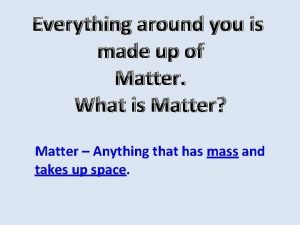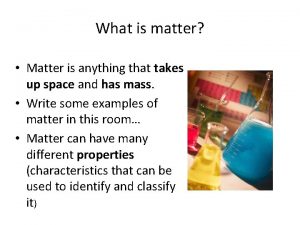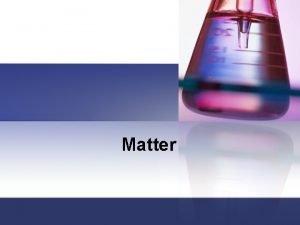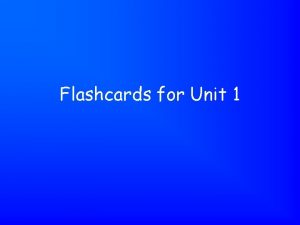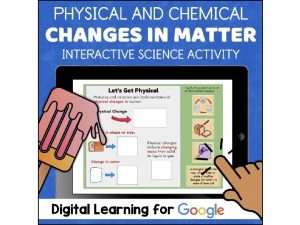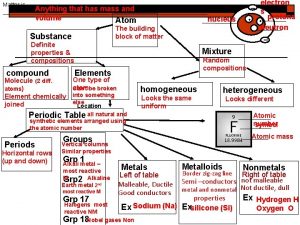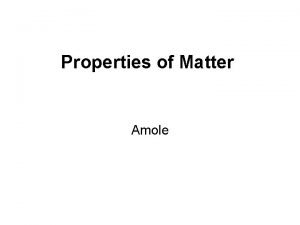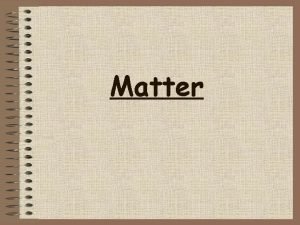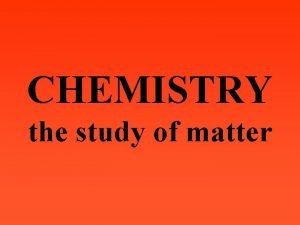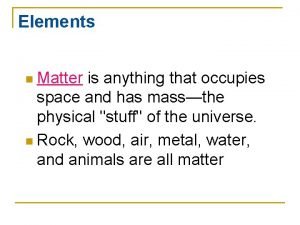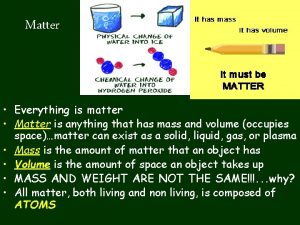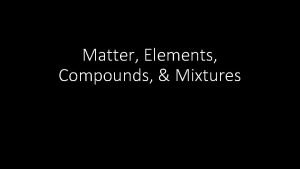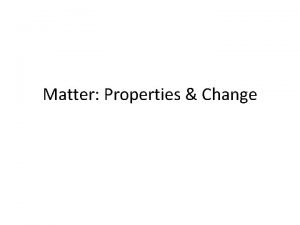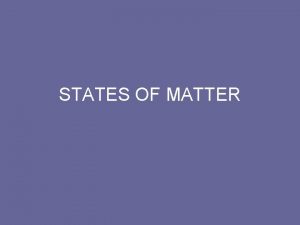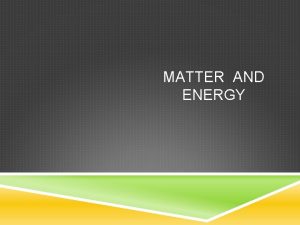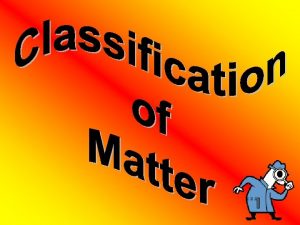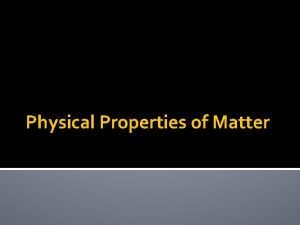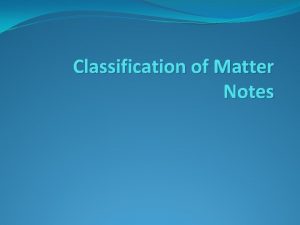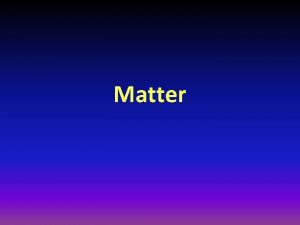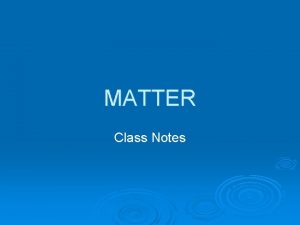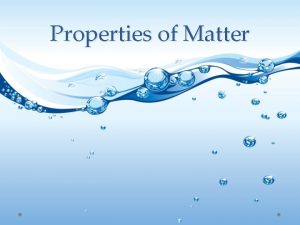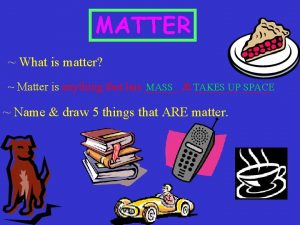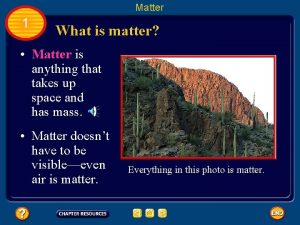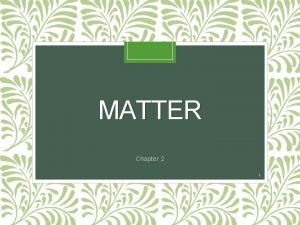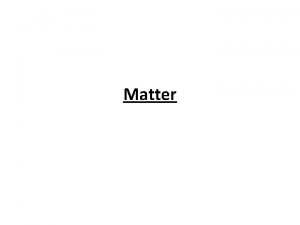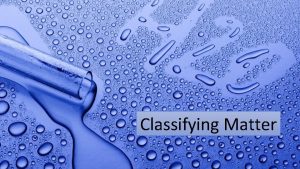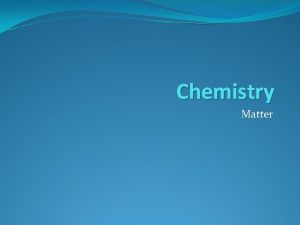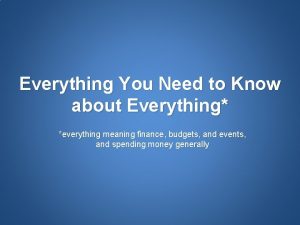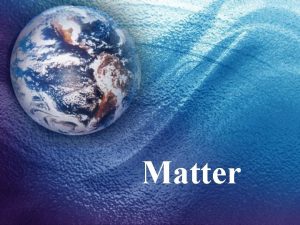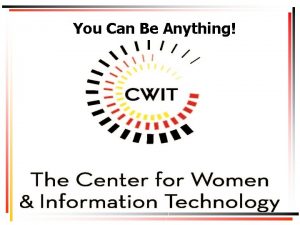What is Matter EVERYTHING Matter is anything that




























- Slides: 28

What is Matter?

EVERYTHING!!!

Matter is anything that has mass and volume. • Mass • Volume The amount of matter in a substance. The amount of space a substance occupies.

Atoms • Atoms are the basic building blocks of all matter. • The smallest particle of matter. • Like the bricks in a house.

Parts of an Atom • An atom’s parts make it different from other atoms.

The Nucleus • At the center of an atom • Made up of two kinds of particles – Protons S U E L C – Neutrons NU

Protons & Neutrons • Each have a mass of about 1 atomic mass unit (amu) • Protons – Carry a positive (+) charge • Neutrons – Have no charge (neutral)

Electrons Ele • Move around in an area outside the nucleus called the electron cloud • Carry a negative (-) charge • Have an insignificant mass compared to protons and neutrons ctr on s

ELE S N O CTR O NS R T U PR OT ON S NE

Elements • Each kind of atom is an element. • An element is a pure substance that cannot be broken down into simpler substances.

• 117 confirmed elements • 90 found in nature – Ex: carbon, oxygen, gold, silver, iron • Other 27 are man-made

Remember: The properties of an element are determined by the structure of its atoms. • The main feature used to distinguish the atoms of different kinds of elements is atomic number. – Atomic Number: the # of PROTONS in the nucleus of an atom. – It’s unique for each element.

A more in depth look at an atom: • Does a carbon atom have a positive or negative charge? – Hint: look at the # of subatomic particles.

Atomic Mass • Protons + Neutrons = Atomic Mass – The mass of a proton is 1 amu – The mass of a neutron is 1 amu – Electrons contribute no mass to an atom. Proton 1 amu Neutron 1 amu Ele No ctro ma n ss

Try a few… Element Carbon (C) Oxygen (O) Sodium (Na) Potassium (K) Iron (Fe) Protons Neutrons Electrons Atomic Mass 6 6 6 12 amu 8 8 8 16 amu 11 11 11 22 amu 19 26 20 29 19 26 39 amu 55 amu

Chemical Symbols • A code, usually one or two letters, that is used to represent a particular element. – Ex. – C=Carbon, Ca=Calcium, Fe=Iron, etc.

Types of Matter • All forms of matter can be classified into four groups based on how the atoms making up the matter are arranged. – Elements – Molecules – Compounds – Mixtures

Mixtures • When two or more substances combine without joining together chemically – The mixture’s parts retain their identity • Heterogeneous – mixed unevenly (can see individual parts of the mixture ex: salad) • Homogeneous – mixed evenly (cannot see individual parts ex: kool-aide) • Mixtures can be separated more easily then compounds or molecules

Pure Substances • Elements, molecules, and Compounds – Have a homogeneous composition • It’s properties and chemical makeup are the same throughout the sample – Cannot be separated by physical means into the parts that make it up.

Compound • Form when two or more different elements join chemically. –Join by sharing electrons

Example of a Compound • Table Salt – Made up of Sodium (Na) and Chlorine (Cl) • Na – soft metal that explodes when combined with water • Cl – poisonous gas – Combine to form the edible, white solid: SALT!

When elements combine to form compounds, they DO NOT keep their individual properties. If they did, we wouldn’t be able to eat salt!

Molecules • Formed when two or more atoms join together chemically. • Compounds contains at least two different elements. • All compounds are molecules, but not all molecules are compounds.

Chemical Formula • Uses chemical symbols and subscripts to identify the number and types of atoms of each element that make up a molecule of a compound. H 2 O Hydrogen + Oxygen = H 2 O

MATTER exists as Pure Substances which include Elements Molecules/ Compounds Made of one type of atom Made of like or different types of atoms Mixtures which include Heterogeneous Mixtures Homogeneous Mixtures

More with H 2 O • Chemical Symbol for Hydrogen • Chemical Symbol for Oxygen • What do you think the “ 2” means? The # of atoms of that element in the substance

Subscript • Written to the right and slightly below a chemical symbol to tell the number of atoms of that element in a substance. • Water – H 2 O – Two molecules of Hydrogen – One molecule of Oxygen

You Try! Common Name Dry Ice Formula How Many? CO 2 C- Table Salt Na. Cl Na- Fool’s Gold Fe. S 2 Fe- Cane Sugar C 12 H 22 O 11 C- 12 H- Rust (Fe 2 O 3)H 2 O Fe- Asprin CH 3 CO 2 C 6 H 4 COOH C- O- 2 1 Cl- 1 1 S- 2 1 9 2 22 O-11 O- 4 HH- 8 O- 2 4
 Tôn thất thuyết là ai
Tôn thất thuyết là ai Phân độ lown ngoại tâm thu
Phân độ lown ngoại tâm thu Walmart thất bại ở nhật
Walmart thất bại ở nhật Gây tê cơ vuông thắt lưng
Gây tê cơ vuông thắt lưng Block av độ 2
Block av độ 2 Tìm vết của mặt phẳng
Tìm vết của mặt phẳng Sau thất bại ở hồ điển triệt
Sau thất bại ở hồ điển triệt Thơ thất ngôn tứ tuyệt đường luật
Thơ thất ngôn tứ tuyệt đường luật Con hãy đưa tay khi thấy người vấp ngã
Con hãy đưa tay khi thấy người vấp ngã Thơ thất ngôn tứ tuyệt đường luật
Thơ thất ngôn tứ tuyệt đường luật Everything around us is made up of
Everything around us is made up of What is occupies space and has mass
What is occupies space and has mass What is matter
What is matter Matter is anything that has and occupies
Matter is anything that has and occupies Matter is anything
Matter is anything Matter anything that
Matter anything that Matter is anything that has both
Matter is anything that has both Matter is anything with mass and volume
Matter is anything with mass and volume No matter anything
No matter anything Defintion mass
Defintion mass Matter is anything that has mass and
Matter is anything that has mass and Matter anything that
Matter anything that Matter anything that
Matter anything that The matter is anything that occupies
The matter is anything that occupies Anything that has matter and takes up space
Anything that has matter and takes up space Matter anything that
Matter anything that Matter is anything that
Matter is anything that Matter anything that
Matter anything that Anything that takes up space and has mass is
Anything that takes up space and has mass is










